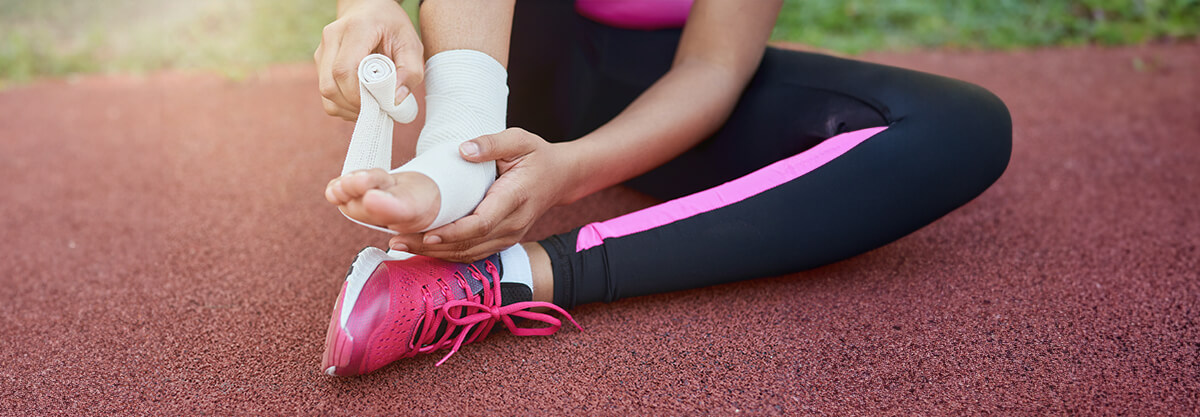
08 Jul, 2024 Common Foot and Ankle Injuries in Athletes: Prevention and Treatment Strategies
Athletes rely heavily on their feet and ankles, making these areas particularly susceptible to injury. Understanding common foot and ankle injuries, their causes, and how to prevent and treat them is crucial for maintaining peak performance and avoiding long-term issues. This guide will cover the most frequent injuries, their symptoms, and effective prevention and treatment strategies.

Common Foot and Ankle Injuries in Athletes
Ankle Sprains
- Description: Ankle sprains occur when the ligaments that support the ankle are stretched or torn, typically due to a sudden twist or turn.
- Symptoms: Pain, swelling, bruising, and limited range of motion.
- Sports: Basketball, soccer, and running are common sports where ankle sprains occur.
Plantar Fasciitis
- Description: Inflammation of the plantar fascia, a thick band of tissue that runs across the bottom of the foot.
- Symptoms: Sharp heel pain, especially after rest or first thing in the morning.
- Sports: Common in runners, dancers, and those involved in high-impact sports.
Achilles Tendinitis
- Description: Inflammation of the Achilles tendon, often caused by overuse or sudden increases in activity level.
- Symptoms: Pain and stiffness along the back of the heel, particularly in the morning or after activity.
- Sports: Track and field, basketball, and other sports requiring running and jumping.
Stress Fractures
- Description: Small cracks in the bones, often caused by repetitive force or overuse.
- Symptoms: Pain that worsens with activity and subsides with rest, swelling, and tenderness.
- Sports: Common in sports involving running and jumping, such as track and field and gymnastics.
Turf Toe
- Description: A sprain of the big toe joint caused by excessive upward bending of the big toe.
- Symptoms: Pain, swelling, and limited movement at the base of the big toe.
- Sports: Frequently seen in football, soccer, and rugby.
Ankle Fractures
- Description: Breaks in the bones of the ankle, ranging from simple cracks to complete breaks.
- Symptoms: Severe pain, swelling, bruising, and inability to bear weight.
- Sports: High-impact and contact sports, including football and basketball.

Prevention Strategies
Proper Footwear
- Importance: Wearing sport-specific and well-fitting shoes provides support and cushioning to reduce injury risk.
- Tips: Choose shoes that match the arch and foot shape, and replace them regularly to maintain support.
Warm-Up and Stretching
- Importance: Warming up increases blood flow to muscles, and stretching improves flexibility, both reducing injury risk.
- Tips: Incorporate dynamic stretches before activities and static stretches after workouts.
Strength Training
- Importance: Strengthening muscles around the foot and ankle provides better support and stability.
- Tips: Include exercises like calf raises, toe curls, and balance drills in your training routine.
Gradual Progression
- Importance: Avoiding sudden increases in training intensity or duration helps prevent overuse injuries.
- Tips: Follow the 10% rule: increase your activity levels by no more than 10% per week.
Proper Technique
- Importance: Using correct techniques reduces undue stress on the feet and ankles.
- Tips: Work with a coach or trainer to ensure proper form in your sport.
Rest and Recovery
- Importance: Allowing time for muscles and tissues to recover helps prevent injuries from overuse.
- Tips: Schedule rest days and listen to your body’s signals of fatigue and pain.

Treatment Strategies
R.I.C.E. Method
- Components: Rest, Ice, Compression, and Elevation.
- Usage: Effective for initial treatment of most acute foot and ankle injuries.
Physical Therapy
- Role: Helps restore strength, flexibility, and range of motion.
- When to Use: Ideal for recovering from severe injuries or surgeries.
Medications
- Types: Nonsteroidal anti-inflammatory drugs (NSAIDs) to reduce pain and inflammation.
- Usage: Consult with a healthcare provider for proper dosage and duration.
Orthotics
- Purpose: Custom insoles can provide additional support and correct biomechanical issues.
- When to Use: Beneficial for conditions like plantar fasciitis and stress fractures.
Surgery
- When Needed: Required for severe injuries, such as complete fractures or torn ligaments.
- Types: Procedures vary based on the injury, from minimally invasive arthroscopy to open surgery.
Gradual Return to Activity
- Importance: Prevents re-injury and ensures complete healing.
- Tips: Follow a structured rehabilitation program and gradually reintroduce sports activities.
Conclusion
Foot and ankle injuries are common among athletes but can be effectively managed with proper prevention and treatment strategies. Prioritizing good footwear, strength training, and gradual progression in activities can significantly reduce the risk of injury. For those who do get injured, early intervention with the R.I.C.E. method and appropriate medical care is crucial for a swift and complete recovery.
